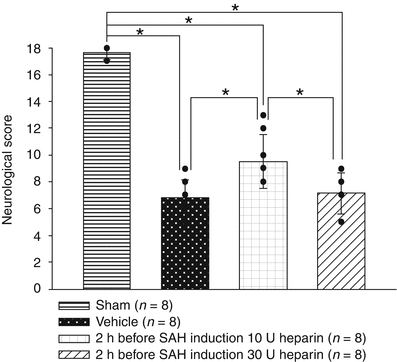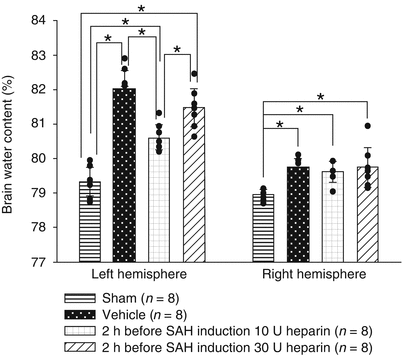Fig. 1
Subarachnoid hemorrhage (SAH) grade at 24 h post-SAH. Values, mean ± SD; *p < 0.05, ANOVA
Neurological Score and BWC
Neurological score was significantly worse after SAH, and a significant improvement was observed only in the 10 U heparin pretreatment group compared with the vehicle group at 24 h after SAH (Fig. 2). BWC in the left cerebral hemisphere was significantly suppressed in the SAH + 10 U heparin pretreatment group but not in the 30 U heparin pretreatment group compared with the vehicle group (Fig. 3). Heparin pretreatment had no effects on post-SAH BWC in the right cerebral hemisphere.



Fig. 2
Neurological score at 24 h after subarachnoid hemorrhage (SAH). Values, mean ± SD; *p < 0.05, ANOVA

Fig. 3
Brain water content at 24 h after subarachnoid hemorrhage (SAH). Values, mean ± SD; *p < 0.05, ANOVA
Discussion
The present study showed that low-dose heparin pretreatment attenuated EBI at 24 h after SAH. Deleterious effects from SAH include disruption of the BBB, amplification of inflammatory infiltrates, and possibly disruption of cell-cell and cell-matrix interactions, which may trigger cell death. Under such a situation, thrombin is produced and dramatically upregulated immediately at sites of cerebrovascular injury and may persist for days after injury [22]. At concentrations below 100 pM, the PAR1-dependent signaling activity of thrombin is protective, but at concentrations of higher than 100 pM, thrombin produces a pro-inflammatory response through the activation of PAR1 in endothelial cells [3] or thrombin-induced PAR1 activation engages multiple signaling mechanisms in multiple cell types, leading to neuronal injury [9, 11].
In 1954, Korn [15] established that the lipolytic activity of the lipoprotein lipase enzyme is heparin dependent. The disappearance of lipoprotein lipase activity appears to parallel the circulating heparin level [15]. Endothelial lipase (EL) is a member of the triglyceride lipase family, which includes lipoprotein lipase and hepatic lipase. EL is principally a phospholipase, with nominal triglyceride lipase activity [14]. EL is synthesized principally by endothelial cells [25] and hydrolyzes high-density lipoprotein (HDL) much more efficiently than other lipoproteins [16]. HDL particles represent the predominant sphingosine 1 phosphate (S1P)-carrier in plasma [6, 21]. Free S1P is also protective at low concentrations [4] but proinflammatory and harmful at high or excessive concentrations [24].
Approximately one-third of an administered dose of heparin binds to antithrombin ΙΙΙ, and this fraction is responsible for most of the anticoagulant effect or antithrombin effect [9], possibly causing increased sphingosine kinase (SphK)1 and S1P, and therefore the antiapoptotic effects [19]. The remaining two-thirds has minimal anticoagulant activity at therapeutic concentrations, but at concentrations greater than those usually obtained clinically it possibly promotes HDL hydrolysis. The resultant over physiological levels of free S1P may antagonize heparin’s protective effects [11, 6, 24]. In addition, 30 U heparin showed a tendency to increase SAH, which potentially causes more severe brain injury associated with a decrease in SphK1 expression [10]. Thus, it is suggested that 10 U heparin was protective, but 30 U heparin lost the protective effects, as this study demonstrated.
Conflict of Interest
The authors report no conflicts of interest.
References
1.
Altay O, Hasegawa Y, Sherchan P, Suzuki H, Khatibi NH, Tang J, Zhang JH (2012) Isoflurane delays the development of early brain injury after subarachnoid hemorrhage through sphingosine-related pathway activation in mice. Crit Care Med 40:1908–1913PubMedCentralCrossRefPubMed
2.
Altay O, Suzuki H, Hasegawa Y, Caner B, Krafft PR, Fujii M, Tang J, Zhang JH (2012) Isoflurane attenuates blood-brain barrier disruption in ipsilateral hemisphere after subarachnoid hemorrhage in mice. Stroke 43:2513–2516PubMedCentralCrossRefPubMed
3.
Bae JS, Kim YU, Park MK, Rezaie AR (2009) Concentration dependent dual effect of thrombin in endothelial cells via Par-1 and Pi3 kinase. J Cell Physiol 219:744–751PubMedCentralCrossRefPubMed
Stay updated, free articles. Join our Telegram channel

Full access? Get Clinical Tree








